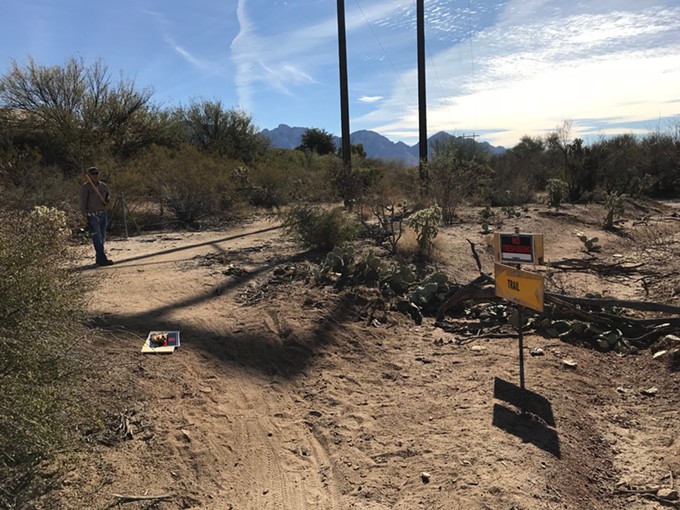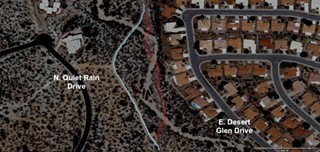A coalition of local businesses, landowners and mountain bike groups working with Oro Valley and Pima County built a new trailhead, back in December, to solve a lengthy controversy over access into the beloved Honeybee Trail system on Tucson's northwest side. But the quarrel continues.
The new trailhead was necessary because a homeowner association cut off access on the trail that mountain bikers had previously used to reach the trail system. And while the collaboration was celebrated at the opening of the Big Wash trailhead, it appears that a new and mysterious group is pretty unhappy with the new status quo.
Despite the new (and legal!) Big Wash trailhead into the trails, which connect to Tortolita Mountain Park and run all the way to Dove Mountain, cyclists continue to use the old WAPA access trail, which runs next to housing subdivisions Rancho Vistoso and Estates at Honey Bee Ridge. Many still use it because it's close to their homes.
Much of the trail strife was between the Honey Bee Ridge Homeowners Association, which manages the utility road in question, and local cyclists, including Sonoran Desert Mountain Bicyclists and mountain-biking Rancho Vistoso residents.
But the latest episode has a twist—old rivals team up to take on a new villain (or antihero, depending on your perspective)—the elusive Honeybee Hucksters.
A little background: In October 2016, the Honey Bee HOA erected a locked gate, blocking access to the Western Area Power Administration Trail 180, or WAPA. Some Honey Bee residents were tired of heavy bike traffic, which could be noisy, dusty and bright.
Pulled into the squabble, Oro Valley issued a formal zoning interpretation, in which Planning and Zoning Administrator Bayer Vella concluded WAPA should be open to both Rancho Vistoso and Honey Bee Ridge residents. The Honey Bee HOA claimed the trail should only be open to Honey Bee residents. Rancho Vistoso residents thought they should have access too. And local cycling groups, who'd been respectfully using the trail for years, thought they deserved access as well.
Unhappy actors filed appeals to the Vella's interpretation. But he convinced them all to cool their jets until the new Big Wash trailhead opened, which would hopefully strike the need for cyclists to use WAPA.
Over the intervening months, before the trailhead opened on Dec. 9, cyclists kept using the WAPA access, lifting their bikes over the new gate. There were other ways into the trails but none were very convenient.
A number of cyclists took the HOA to Superior Court in Tucson, arguing for "prescriptive easement" use of the trail because they had been using it continuously for over a decade.
In December, the court granted the cyclists access, with a condition that the HOA would pay SDMB a fee to reroute the trail off of where it cuts across four private lots.
The temporary agreement that the HOA came to with Oro Valley still stood: The trail was open to Rancho Vistoso residents. But the HOA continued to fret about the volume of bike traffic on the trail and made it clear they were willing to pursue further litigation if something didn't give.
SDMB had been making strides to heal bad blood with the Honey Bee HOA, working to find a solution to appease all parties. The HOA, with contributions from neighborhood residents, hired SDMB to reroute the trail off the lots, moving vegetation and erecting No Trespassing signs.
Dec. 16 and 17, two experienced trail builders, along with several helpers, spent two full days rerouting 800 feet of trail, moving it back into the 100-foot-wide WAPA easement, according to Evan Pilling, a SBMD member who oversaw the project.
They closed the old route by moving and replanting prickly pear and cholla cactus and strewing tree branches around, creating a four- to six-foot-wide barrier of vegetation on either side of the section of trail that ran onto private property.
They also installed five or six No Trespassing signs on the private lots and posted a sign on either end to explain the situation. It included the reason for the reroute, a list of trail etiquette tips and directions that the trail was only for Rancho Vistoso residents.
SDMB also put up a Facebook post, explaining what they had done and why, with a plea to the mountain bike community: "If you are not a Rancho Vistoso resident, please do not use the WAPA Trail." Four days later, someone destroyed their work and removed the signs and vegetation.
That same day, Pilling and another cyclists received an email from Robert Lewis, who runs a local bike rental and tour company, biketucson.com. The email was later given to the Oro Valley Police Department, who supplied it to the Tucson Weekly. Lewis was outraged about the trail being rerouted and asked for an explanation, adding there were "shards" all over the ground. He also said he had gathered volunteers to put the trail back how it was.
"The metal poles have to be taken down as well since they were posted without a permit—and pose a safety hazard," he wrote. "They [volunteers he gathered] will be removing all of that shortly. I will be back out their (sic) tomorrow to go over the entire area with a rake to make sure any and all debris has been cleaned up. So, who did this? Who booby trapped the road with the cactus?"
Pilling wrote back, explaining the situation and saying he had no idea why there would be any shards or non-organic materials on the new or old trail.
Honey Bee HOA President Rolf Sigford reported the issue to OVPD. He said he didn't know who did it but that he would soon be going back to court to fight for a new gate to block access to the route entirely, according to police reports. Another Honey Bee property owner, who owns one of the properties crossed by the WAPA bike trail, also filed a police report, saying she had contributed $250 to the project.
SDMB went out again to fix the trail and post signs on Jan. 6—this time, with a team of volunteers. They made another detailed Facebook post with the following admonition: "If anyone sees work being done on the old WAPA trail to remove signs or vegetation please know that they are trespassing and are threatening access to the Honeybee trail system for all Rancho Vistoso residents."
Within 45 minutes, five of the seven No Trespassing signs were torn down, including someone ripping a four-by-four post out of the ground, according to an SDMB Facebook post that was accompanied by photos of the signs spray painted with profanities and personal insults to current and former SDMB members.
Sigford called police again. He didn't see who removed the signs, but told police he had come across Lewis on the trail just before he saw the uprooted signs. He said that Lewis "made comments in regards to the barriers and sign," the police report said.
Pilling also told police he was with Sigford on the trail the day of the rebuild, and they ran into Lewis. He said Lewis was "being confrontational and borderline threatening" and said he would be back to remove the trespass signs, according to reports. The police report also said Lewis is with the "Honeybee Hucksters."
"Apparently we closed down his favorite section of dirt road," Pilling said in an interview. "We're not talking about world-class trail. We're talking about 800 feet of dirt road."
Pilling said he spoke with local bike shop employees who saw Lewis, "tools in hand," undoing SBMD's work.
Police spoke with Lewis by phone later that day, and he said he wasn't involved other than having "encouraged" the removal of "booby traps" from the WAPA trail. He said the changes to the trail were a hazard, which included prickly pear cactus and glass shards, and that undoing the new trail was done by a group of area residents who call themselves the "Honeybee Hucksters." He also told police he never saw any "no trespassing" signs while simultaneously complaining that the metal poles are an impediment.
OVPD determined they didn't have enough evidence to press charges against anyone.
So what does a curious and thorough Tucson Weekly journalist do to get to the bottom of this? Well, she calls Robert Lewis, of course.
When I called the number on biketucson.com, a jovial man answered the phone and identified himself as Robert. I told him I was a reporter writing about WAPA, at which point he told me he was not Robert Lewis, but a different Robert and would have the real Robert Lewis call me. I sent Lewis an email as well.
I never did hear back from Lewis, though I tried to reach him several more times. But I did start getting calls from other cyclists, at Lewis' behest. They were upset to hear (mostly from Lewis) that the WAPA trail had been "booby trapped."
After spending 20 minutes explaining to people, one by one, the entire story you have just read, they were mostly just relieved to hear about the Big Wash trailhead. Eventually, I decided to text a novella-length backstory to anyone who called to complain, saying I'd be happy to talk after they read the backstory to start on the same page. I didn't get any more angry calls after that.
Rancho Vistoso homeowner and cyclist Shantal Dubois was one trail user that Lewis sent my way. She saw people reworking the trail but had no idea what was going on. She says she asked one of the guys working, and he told her it was none of her business.
Dubois also saw glass on the old trail and said bits of cactus were just strewn around. It's not clear whether she saw that mess before or after the "Honeybee Hucksters" were done with it. She also said the new trail goes through a wash and is too soft to ride in.
She didn't know the backstory or that the new trail was made in an effort to maintain access to the trail for her and her neighbors—apparently, that wasn't the part of the story Lewis decided to pass on. After hearing it, she was understanding but wished she had been informed and that the new trail was better marked.
Pilling said indeed the new trail does go through a sandy wash, and it's not ideal. But they didn't have a choice, since they're working with a 100-foot-wide easement. They crossed the trail at 90-degree angles over the wash to minimize the time spent in it.
Vella said he heard from cyclists that the new trail is fine. He also said this latest chapter has got the HOA thinking about the future and whether to pursue a formal appeal into his zoning interpretation that the easement is open to Rancho Vistoso residents.
"It's all about putting the trail back in the confines of the legal easement," Vella said. "At the end of the day, this is about property rights where people are going to build their homes."
If the HOA appeals, it will go to the council-appointed Board of Adjustment, where all parties will be able to make their case. The board will decide what they think is fair—there will be a winner and a loser. And if the loser decides to appeal, it will go to Superior Court.
But in the meantime, the mystery still remains: Who are the "Honeybee Hucksters," and why do they (and Lewis) care so much about a nominal section of dirt road?











